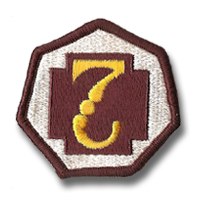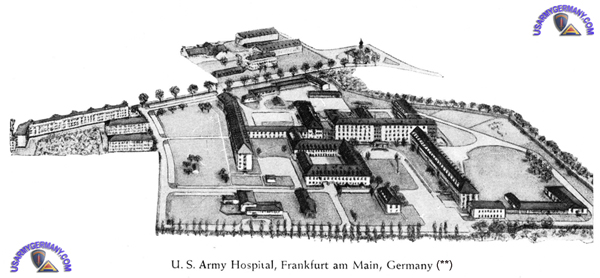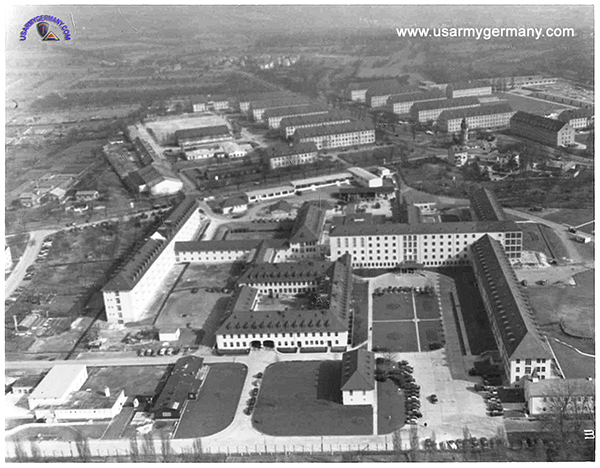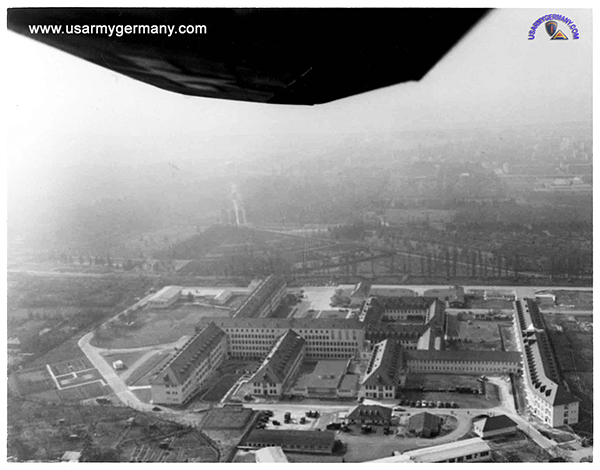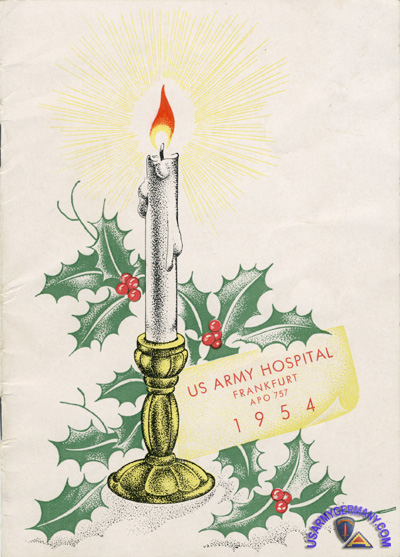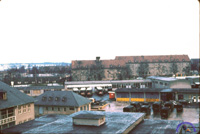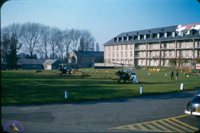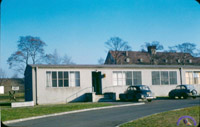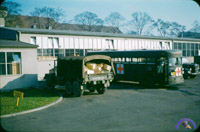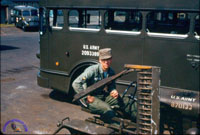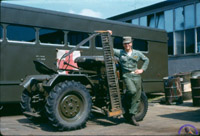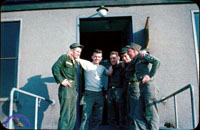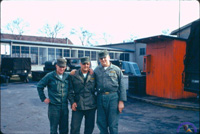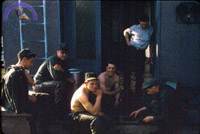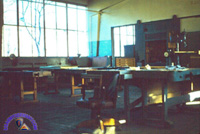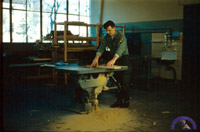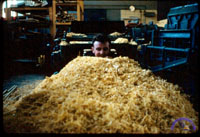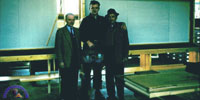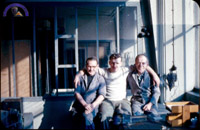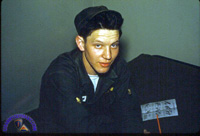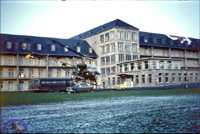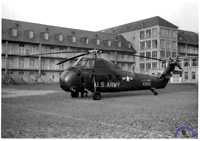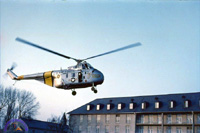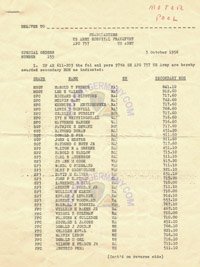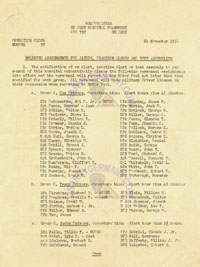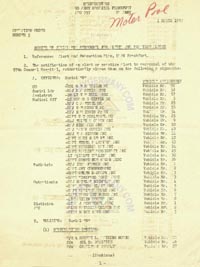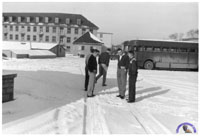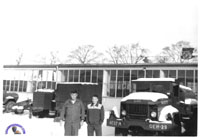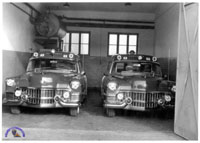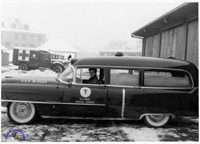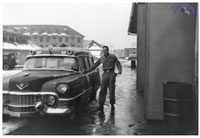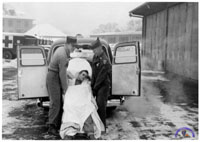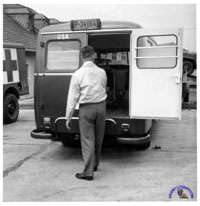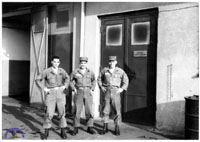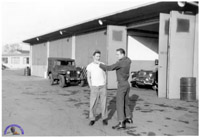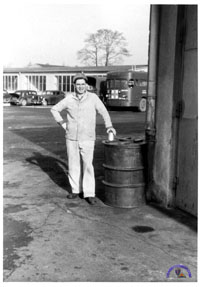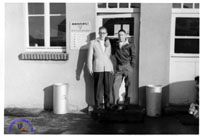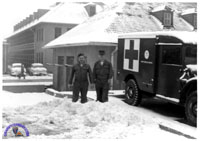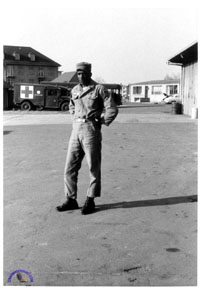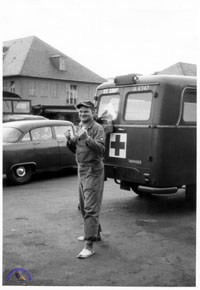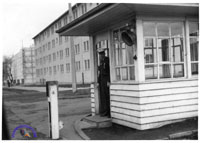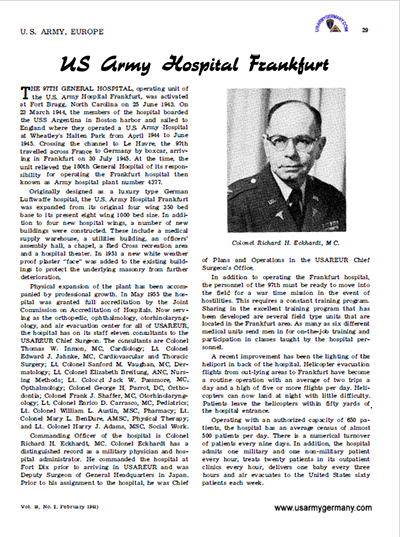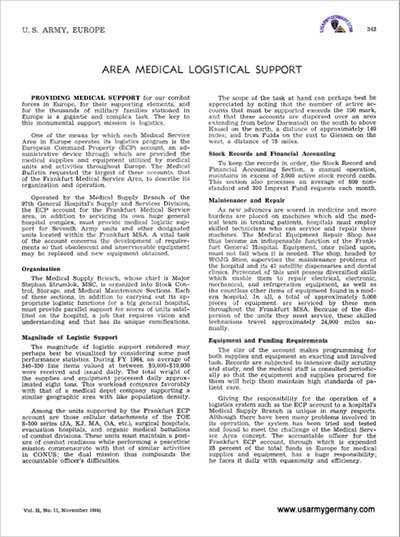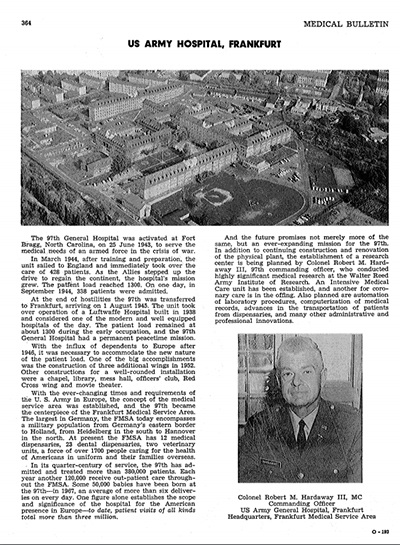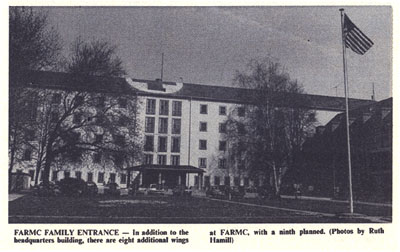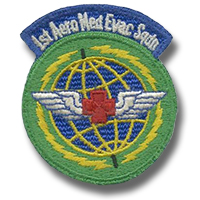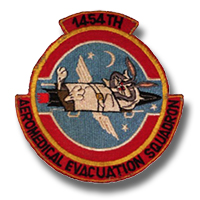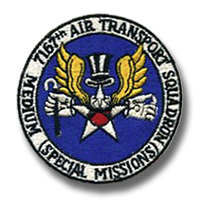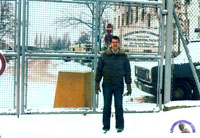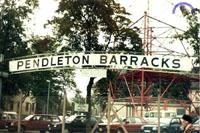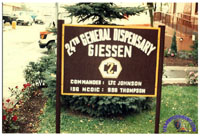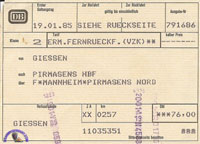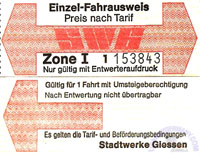| If you do
NOT see the Table of Contents frame to the left of this page, then
Click here to open 'USArmyGermany' frameset |
|||||||||||||||||||||||||||||
USAH Frankfurt |
|||||||||||||||||||||||||||||
|
|
|||||||||||||||||||||||||||||
|
|||||||||||||||||||||||||||||
|
|
|||||||||||||||||||||||||||||
| USAH Frankfurt History | |||||||||||||||||||||||||||||
| 1945-46 | |||||||||||||||||||||||||||||
| (Source: USAREUR Military History Office - Online Medical Histories, 2002) | |||||||||||||||||||||||||||||
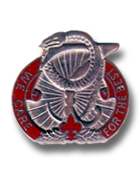 97th General Hospital DUI
97th General Hospital DUIWhen the 97th General Hospital arrived in Frankfurt in July of 1945, it found a German hospital, completed in 1941, which was quite well equipped to take care of injured and ill Luftwaffe personnel -- and occasionally a captured American airman. An architect's mural which still stands near the main entrance of the hospital indicates the sweeping landscapes and decorative gardening which had been planned. The leisurely, oval approach to the main entrance, the curved foyer and hidden courtyards, the long unsymmetrical ward buildings and the expansive parks which surrounded the hospital were the materials from which the Luftwaffe was going to mould an impressive institution. Originally, the hospital consisted of a main building seven thousand and seventy nine square meters in size, with five floors, four wings, a basement and sub-basement; an isolation building seven hundred and ninety square meters in size, with three floors; a utilities building two hundred and ninety square meters in size, with two floors; a generator building and a transformer building. When the Americans took the hospital for an installation of their own, several temporary buildings were constructed for additional facilities. Fourteen hospital Nissen-type hutments were added for convalescent wards; an enlisted men's recreational center was built with a bar and dance floor; three rectangular buildings were built for utilities work shops; a Red Cross building for patients' recreation was erected, as well as a timber type dining room being added to the official mess. Approximately two hundred and thirty apartments were added to the hospital installation when a neighboring block of apartment buildings was assigned to the hospital for use in October of 1945. Between these apartment buildings and the hospital itself was a large gardening area which also became the property of the United States Army and later provided food and flowers for the use of the hospital. Altogether the installation covers almost twenty acres of land. During the period 1 August 1945 to 31 May 1946, the 97th General Hospital admitted more than 14,000 patients to the hospital, some 13,000 being US Army personnel and approximately 1,300 being non-US. At the same time, 87,910 patients were treated at the outpatient dispensary. At one time the hospital had 980 of its authorized 1,000 T/O beds occupied. The 97th General Hospital is one of the best equipped US Army hospitals in Germany. Its facilities compare favorably with hospitals of similar capacity in the States. Because of its central location, it has been designated as a special treatment center, being capable of caring for all types of cases normally treated in an overseas theater. Recently a pediatric section has been added to the many specialized sections of the hospital, including gynecological, pre-natal and post-natal clinics, and the hospital is completely prepared to handle all admissions and treatments of this type. Since September 1945, the 97th General Hospital has been commanded by Colonel Stewart G. Smith, MC, who is ably assisted by Lt Col T.M. Carow, MC, his executive officer, and a well qualified professional staff. While redeployment has taken a heavy toll of specialists and presented many problems, the 97th General Hospital maintained a staff comparable to its facilities. As of 15 June 1946, the Medical Service was headed by Major S.S. Altshuler, MC, while Col Edmund Horgan, MC, was enroute to replace Capt O.R. Beusing, MC, as Chief of Surgical Service. The Dental Service was headed by Lt Col C.M. Farber, DC, and the Nursing Service, by Lt Col Doris E. Medlin, ANC; the Laboratory Service by Capt M. Kuschner, MC, and the X-Ray Service by Capt S.P. Barden, MC. Serving under the chiefs of services are specialist in gynecology and obstetrics, orthopediatrics, neuropsychiatry, dermatology, neuro-surgery, diseases of the eye, ear, nose and throat, and other branches of medicine and surgery, completing a team competent to give American soldiers the best medical service of any Army in the world. |
|||||||||||||||||||||||||||||
|
|
|||||||||||||||||||||||||||||
(**) Mural at 97th GH? Click on image to view high res. |
|||||||||||||||||||||||||||||
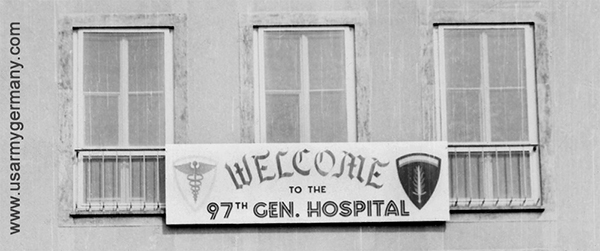 Sign over the entrance to the main building, 97th General Hospital, early 1950s |
|||||||||||||||||||||||||||||
|
1945-1950s
|
|||||||||||||||||||||||||||||
| (Source: USAREUR Military History Office - Online Medical Histories, 2002) | |||||||||||||||||||||||||||||
|
UNIT
HISTORY OF THE 97TH GENERAL HOSPITAL
In July, 1923, General Hospital No. 97 was constituted in the organized Reserves in the State of Florida. The unit was redesignated as the 97th General Hospital in June, 1929, and on 25 June 1943 it was ordered into active duty at Fort Bragg, North Carolina. On 23 March 1944, the 97th General Hospital set sail aboard the USS Argentina for what the troops considered parts unknown. On 3 April 1944 the unit docked at Greenock, Scotland and walked onto British soil on the way to a new home at Wheatley, England, six miles from Oxford. On 22 April 1944, the 97th General Hospital officially took command of hospital plant 4143 and began furnishing fourth echelon medical care for troops in the European theater of operations. As was expected, the invasion of the continent and the bloody push up the Normandy peninsula by the allied armies, sent the 97th into high gear. Six days after D-Day, the 97th unloaded its first train load of injured, and by 2 August 1944, 1,449 battle casualties reached the 97th General Hospital. With a sense of satisfaction in a job well done, the 97th General Hospital began preparations for another move in early spring of 1945. On 29 March, the 385th Armored Battalion captured a huge hospital plant constructed by the German Air Force (Luftwaffe) in the battle for Frankfurt/Main, and held it until 15 April when the 180th General Hospital occupied the building and grounds -- in time this was to be the permanent station of the 97th General Hospital. The 97th departed Wheatley on 30 June 1945 and headed for France. Four days later they arrived at Le Havre, France where for twenty days the troops waited. On 30 July, 400 days after the units activation, the 97th General Hospital formally took up residence at Army Hospital Plant 4377 in Frankfurt/Main, Germany. Upon arrival at the 97th General Hospital in Frankfurt, all personnel worked diligently and tirelessly to solve the many problems initially encountered in the new facility. With the influx of dependents to Europe after 1946, it was necessary to accommodate to the new nature of the patient load. One of the big accomplishments was the construction of three additional wings (F, G and H) in 1952 followed by construction of an emergency room, chapel, library, mess hall, officers' club, and a theater. The 97th was selected for special service to aid in the Berlin air-lift in 1948-49; for its support of the operation, it was awarded the "Army of Occupation Medal with the Berlin Air-Lift Device". On 1 January 1954, the hospital was redesignated US Army Hospital, Frankfurt operated by the 97th General Hospital with a total expandible bed capacity of 1,000. The 97th General Hospital and the Frankfurt Army Regional Medical Center (FARMC) is the largest and busiest in Europe. Comprised of 11 troop medical clinics, 22 dental clinics, 3 veterinary detachments and numerous other field and TO&E units spanning a 100 mile radius. The 97th General Hospital is authorized an operating bed level of 330 plus 30 remaining overnight beds for evacuation patients. The hospital functions as the medical evaluation center for patients being evacuated to the United States. It also operates a regional neonatal intensive care unit for the dependents of US Army Forces in Europe. The hospital provides specialized treatment in 22 areas to include: allergy, audiology, cardiology, dermatology, gastroenterology, internal medicine, dentistry, neurology, obstetrics and gynecology, orthopedics, pediatrics, pulmonary disease, psychiatry, rheumatology and urology. The 97th General Hospital and the Frankfurt Army Regional Medical Center continues to function as the home of concerned care. |
|||||||||||||||||||||||||||||
| If you have more
information on the history or organization of the 97th Gen Hosp/USAH
Frankfurt/FARMC, please contact me |
|||||||||||||||||||||||||||||
1952 |
|||||||||||||||||||||||||||||
| 1954 | |||||||||||||||||||||||||||||
| MOTOR POOL, 97th GH | |||||||||||||||||||||||||||||
| 1956-57 | |||||||||||||||||||||||||||||
| (Source: Email from Jim Gibson, 97th Gen Hosp -- see also email 34th Hospital Train) | |||||||||||||||||||||||||||||
| I was assigned to the Utility Section at the 97th Gen Hosp from April 1956 to August 1957 | |||||||||||||||||||||||||||||
| ADDITIONAL PHOTOS | |||||||||||||||||||||||||||||
|
|||||||||||||||||||||||||||||
| 1956-57 | |||||||||||||||||||||||||||||
|
|||||||||||||||||||||||||||||
| (Source: STARS & STRIPES, Jan 3, 1956) | |||||||||||||||||||||||||||||
The Dental Clinic loacted at the Frankfurt Army Hospital is one of the finest in the US Army. A high percentage of oral surgery cases are traumatic head injuries, while most other patients are treated for infections, cysts and tumors. The operative surgeons perform restorative work, accomplishing all routine fillings. The prosthetic section provides full and partial denture replacements. |
|||||||||||||||||||||||||||||
| 1961 | |||||||||||||||||||||||||||||
| 1964 | |||||||||||||||||||||||||||||
| (Source: STARS & STRIPES, Nov 5, 1964) | |||||||||||||||||||||||||||||
| There are two orthodontists assigned to the Frankfurt Medical Service Area, Maj Antonio J. Venenzia and Capt William N. Dosier. Besides providing dental care to US military and authorized civilian personnel and their families within the MSA, the two also provide back-up orthodontic care to the Berlin and Bremerhaven communities. Once a month, one of the two doctors travels to the two outposts to provide his services for several days (2 days in Berlin, 1 day in Bremerhaven). The other doctor stays in Frankfurt to assure that one orthodontist is available at the Frankfurt Army Hospital. This program was initiated to provide personnel at the two outposts on-the-spot service and insure that all dependent children in Berlin and Bremerhaven receive the same care as those in the Frankfurt area. |
|||||||||||||||||||||||||||||
| 1968 | |||||||||||||||||||||||||||||
| 1982 | |||||||||||||||||||||||||||||
| (Source: MEDCOM Examiner, August 1982) | |||||||||||||||||||||||||||||
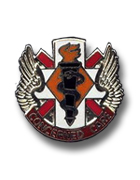 Frankfurt Army Regional Medical Center DUI Frankfurt Army Regional Medical Center DUIFARMC: Home of concerned medical care By Ruth Hamill Editor's note: This is the third in a series of articles highlighting 7th MEDCOM facilities. Future issues of the MEDCOM Examiner will feature each of the MEDDACs, MEDCENs and other MEDCOM treatment facilities in a series of articles designed to further acquaint readers throughout 7th MEDCOM with each facility. City life may not be for everyone, but for those assigned to the Frankfurt Army Regional Medical Center, it does have its advantages. Frankfurt is a major financial, industrial, commercial and transportation center of Europe and offers many opportunities not as readily available in a smaller, less centrally located community. |
|||||||||||||||||||||||||||||
|
|||||||||||||||||||||||||||||
| The building,
now housing FARMC and the 97th General Hospital, was originally constructed
between 1938 and 1944 and at that time was one of the most modern
in Germany, having such uncommon features as elevators. Upon approval
from Hitler, architect Professor Bonatz approached the design of the
"Hermann Goering Luftwaffe Hospital" as if it were a factory, with
the end product being the operation. It was designed to hold 300 beds
in peacetime, with expansion capabilities to 600 beds without any
structural changes. An unusual characteristic in the construction
was the use of steam pipes which served both as heating elements and
as reinforcement for the cement walls and ceilings. The method was
used to economize steel which was needed for the armament industry.
Construction was completed in time for the invasion of Poland and
the arrival of the first casualties. Americans in the middle During the hospital's occupation by the Germans it was used as a 350-bed luxury Luftwaffe hospital. The A-wing was occupied by patients with a prolonged recovery period and by Allied prisoners needing hospitalization. The French prisoners were kept on the ground floor, the Americans on the second, and the British on the third. Supposedly this pattern developed because the Germans had some respect for the French, less for the Americans and least of all for the British; hence, any bombings would inflict the greatest casualties on the upper floors where the British were hospitalized. (The hospital received no damage from air attacks during World War II). The Germans are believed to have had more respect for the French because they did not participate in the air raids which destroyed many German cities. On March 29, 1945, the 385th Armored Battalion of the U.S. Army captured the hospital plant in the Battle for Frankfurt/Main and held it until April 15 when the 180th General Hospital occupied the building and grounds. It became the permanent station of the 97th General Hospital on July 30, 1945, just 400 days after the unit's reactivation for World War II. Prior to arriving in Frankfurt, the 97th furnished fourth echelon medical care to troops in the European theatre from Hospital Plant 4143 in Wheatley, England, eight miles from Oxford. |
|||||||||||||||||||||||||||||
|
|||||||||||||||||||||||||||||
| Currently the
hospital has 310 beds, with expansion capabilities to 1,000. It is
the air evacuation center for MEDEVAC flights to the States and maintains
an additional 30 beds for MEDEVAC patients who stay there overnight
before flying to CONUS. In March, there were approximately 39 admissions
per day with the average length of stay slightly longer than six days.
About 238 beds were occupied each day. The 97th averages six live
births daily. There are more than 1,800 daily clinic visits to the
97th and all outlying clinics. In addition to the 97th General Hospital
and the clinics, FARMC includes the 110th Medical Detachment (Veterinary
Services) commanded by Lt. Col. Max E. Coats, Jr. The Frankfurt DENTAC,
commanded by Col. Allen W. Brown, is co-located with FARMC. There
are 22 outlying dental clinics operated by the three dental detachments
which make up the Frankfurt DENTAC. Location offers much Col. John F. Taylor, MC, has commanded FARMC since his arrival from the Ft. Knox MEDDAC in August 1980. While discussing the command at FARMC he said, "Frankfurt is different from other locations and that is a mixed blessing. Because it is a large metropolitan community there is a traffic problem. It can also be difficult to find economy housing. On the other hand, it is a major air and rail terminus which gives our people a greater opportunity to travel in Germany and Europe. In such a large, bustling community there are many possibilities for both the single soldier and the soldier here with a family." As of July, there were more than 2,000 people working at FARMC, the Frankfurt DENTAC and all of the outlying health and dental clinics. Of the 323 officers, 76 belong to the Medical Corps, 48 to the Medical Service Corps, nine to the Army Medical Specialists Corps, 83 to the Army Nurse Corps, 97 to the Dental Corps and four to the Veterinary Corps. There are also two Warrant Officers and four Chaplains. There are more than 1,000 enlisted people and upwards of 650 civilians. In addition to the high risk obstetrics and neonatal intensive care facilities, FARMC also has the only eye laser available in the Army's facilities in Europe. According to Col. Charles Daily, MC, chief of the Eye Clinic, the laser is used to treat various types of eye problems, for example, diabetics suffering from retinal detachments or tears to the retina. He sees three to five people daily on a referral basis. FARMC also has a thriving Nurse-Midwifery Service headed by Maj. Jeri Graham. Since July 1978 the service has been providing care for normal mothers and their newborns in collaboration with the FARMC Department of Nursing and the Department of Obstetrics and Gynecology. A Board Qualified Obstetrician is appointed to provide medical direction for the Nurse-Midwifery Service and an obstetrician is accessible for consultation with the nurse-midwifes in the clinical setting. The service is currently handling about one-third of the vaginal deliveries at the hospital. EHIS Prototype According to Col. Jack Story, Jr., executive officer at FARMC, the MEDCEN also has plans to expand its computer capabilities. The 97th is the prototype site for the European Hospital Information System (EHIS). Although the hardware is installed and Story anticipates the first program will be on line by September, it will take at least three years before all remaining programs are on line. So in spite of its rich past, FARMC, like Frankfurt, has its eye on the future. Dr. Taylor said that the new equipment at FARMC is better than what many doctors had available in their residencies. He added, "But it's not only the equipment, it's the people who make this place. This is the finest group of people I have ever worked with." Although FARMC is offering high quality care in an up to date facility today, tomorrow will see many improvements both in the facilities and in the services provided by this fine metropolitan medical center. |
|||||||||||||||||||||||||||||
|
|
|||||||||||||||||||||||||||||
| Air Evacuation Center, 97th General Hospital | |||||||||||||||||||||||||||||
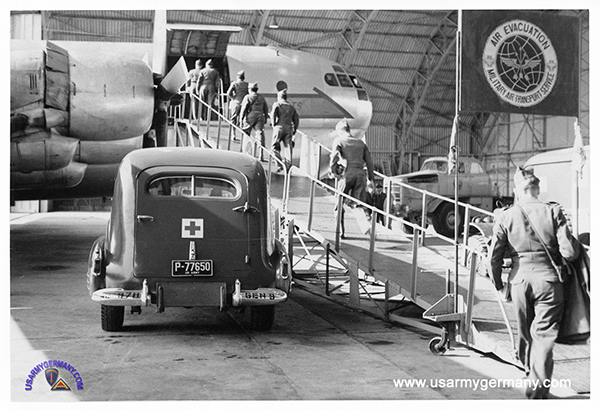 Medical air evacuation from Rhein-Main Air Base, 1952 (Webmaster's collection) |
|||||||||||||||||||||||||||||
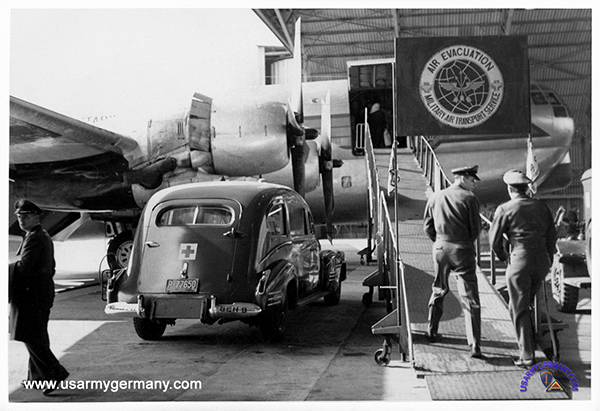 Medical air evacuation from Rhein-Main Air Base, 1952 (Webmaster's collection) |
|||||||||||||||||||||||||||||
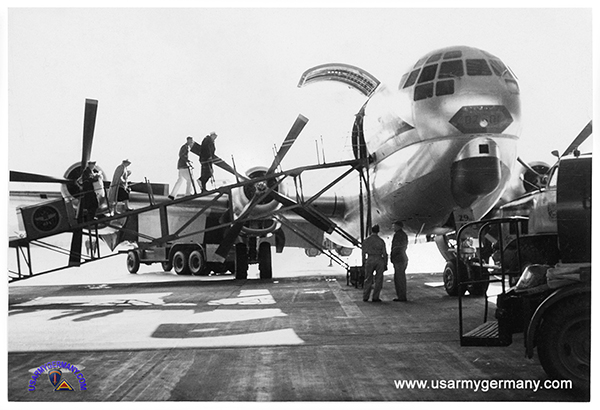 C-97 Stratofreighter being used for medical air evacuation, Frankfurt (Webmaster's collection) |
|||||||||||||||||||||||||||||
1950 |
|||||||||||||||||||||||||||||
| (Source: EUCOM Medical Bulletin, June 1950) | |||||||||||||||||||||||||||||
Prior to 1 October 1949, patients boarded for return to the ZI (Zone of Interior - later known as OCONUS) were evacuated by hospital ship. The U.S. hospital ship "Comfort" sailed from the Bremerhaven Port of Embarkation about every forty days. Evacuation of patients from the European Command to the ZI by military aircraft became effective 1 October 1949 except for those patients whose travel by air is contraindicated medically or otherwise. Aircraft utilized for evacuation are of the C-121 (Constellation) type. Each plane at present transports twelve litter and 26 ambulatory patients. It may carry ten neuropsychiatric cases, not to exceed five "Class l Able" or "1 Baker" or a combination thereof. As soon as planes become available, hospital commanders are instructed as to the number of patients by class and sub-class to be prepared for evacuation, and informed of arrangements to be made for transfer to the Air Pre-Embarkation Holding Hospital, which is now the 97th General Hospital, Frankfurt/am Main, Germany. If they are to be evacuated by ship, they are transferred to the 319th Station Hospital, Bremerhaven. The number of patients evacuated by air and water during the period October 1949 - March 1950 is shown the graphic below: |
|||||||||||||||||||||||||||||
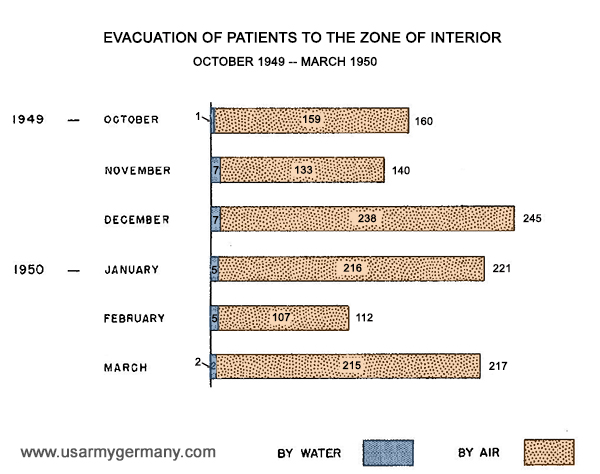 |
|||||||||||||||||||||||||||||
1951 |
|||||||||||||||||||||||||||||
(Source: STARS & STRIPES, Jan 28, 1951) |
|||||||||||||||||||||||||||||
In January 1951, the Atlantic Division of MATS (Military Air Transport Service) at Westover AFB, Mass. notified the 1602nd Air Transport Wing (USAFE) at Rhein-Main Air Base that it has developed tentative plans to utilize C-97 Stratofreighters to supplement the C-121 air evacuation flights from Rhein-Main to Westover. The proposed plan calls for four C-97s a month to depart from Rhein-Main with a load of patients for hospitalization in the U.S. Utilization of the larger, double-decked cargo planes would increase the load by 18 patients per flight. Currently, the C-121 carries a maximum of 37 patients. In October 1949, MATS assumed responsibility for air evacuation on a world-wide basis. The first C-121 used for air evacuation in Europe flew on Oct. 11, 1949 with 19 litter and 16 ambulatory patients. Since MATS assumed the air evacuation mission in Europe, an average of 165 patients a month have been transported to the US for further medical treatment. |
|||||||||||||||||||||||||||||
1951 |
|||||||||||||||||||||||||||||
(Sources: STARS & STRIPES, July 2, 1951 & Lineage and Honors, 1st Aeromedical Evacuation Squadron) |
|||||||||||||||||||||||||||||
|
|||||||||||||||||||||||||||||
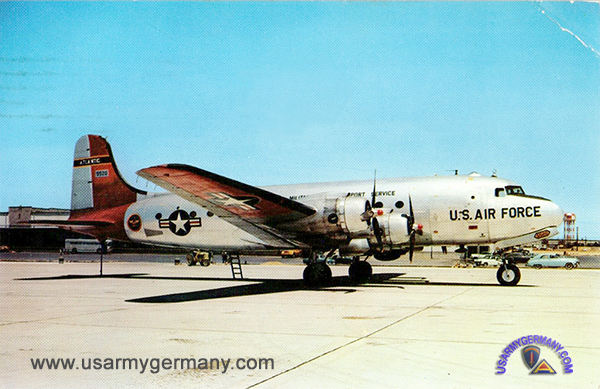 C-54 specially equipped for air evacuation missions (Webmaster's collection) |
|||||||||||||||||||||||||||||
1952 |
|||||||||||||||||||||||||||||
(Source: STARS & STRIPES, May 18, 1952) |
|||||||||||||||||||||||||||||
A vast aerial network puts every service member in the European Command within a few hours of the best medical care possible. Scheduled air evacuation flights and special emergency missions, when conditions warrant, transport patients to one of four military hospitals in Germany, of which three are Army hospitals (97th Gen Hosp, Frankfurt; 98th Gen Hosp, Munich; and 5th Gen Hosp, Bad Cannstatt) and one Air Force hospital (495th Gen Hosp, Wiesbaden). The primary transport agencies are the 1st Medical Air Evacuation (MAE) Sq (USAFE) at Rhein-Main AB, providing inter-zonal pickup, and the 1454th MAE Sq (MATS), also Rhein-Main AB, which provides inter-zonal as well as inter-theater pickup. 1st Aermedical Evacuation Squadron provides seven scheduled flights weekly within the zone. Utilizing four litter-equipped C-47s assigned to them from the 60th Troop Carrier Wing, the 1st sends a nurse and a technician on flights to Pisa, Italy; Bordeaux, France; Buronwwod, England; and to Paris, France. |
|||||||||||||||||||||||||||||
|
|||||||||||||||||||||||||||||
1955 |
|||||||||||||||||||||||||||||
(Source: STARS & STRIPES, Sept 3, 1955) |
|||||||||||||||||||||||||||||
|
|||||||||||||||||||||||||||||
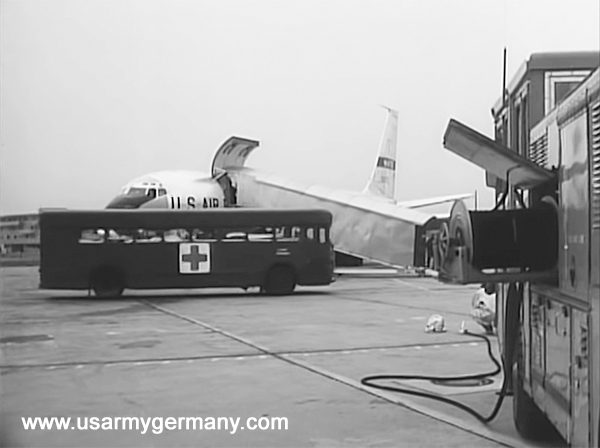 97th GH hospital bus arrives on tarmac at Rhein-Main AB (BIG PICTURE Television series) |
|||||||||||||||||||||||||||||
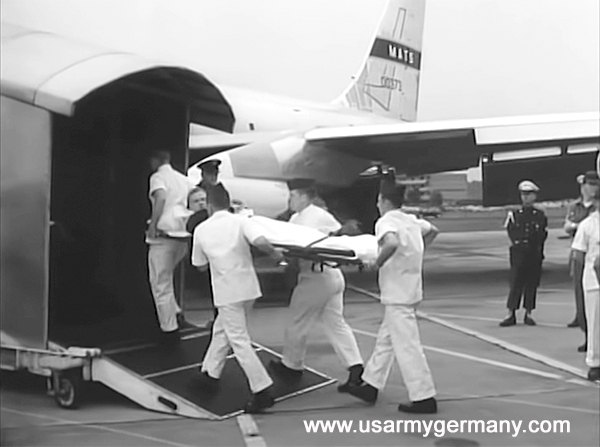 A litter patient is carried on board (BIG PICTURE Television series) |
|||||||||||||||||||||||||||||
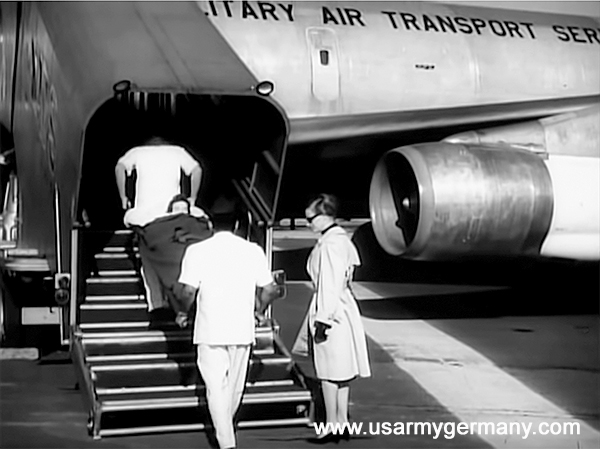 In addition to military patients, dependents and civilian personnel are also authorized to be air evacuated when necessary, as in this case with an accompanying parent |
|||||||||||||||||||||||||||||
1957 |
|||||||||||||||||||||||||||||
(Source: STARS & STRIPES, June 5, 1957; images above are from an episode of the BIG PICTURE TV series released in the early 1960s **) |
|||||||||||||||||||||||||||||
The USAREUR Air Pre-Embarkation Holding Hospital, aka the Army Air Evacuation Center, is operated by the 97th Gen Hosp, Frankfurt. The center - a combined Army-Air Force operation - evacuates military personnel who require hospitalization of more than 120 days (or more than 90 days for civilian personnel and dependents) or who are in need of further medical care. It receives and ships patients who come from military installations in Europe, Africa or the Middle East. At the Air Evac Center patients are made ready for the Atlantic flight via MATS medical air evacuation aircraft to McGuire AFB in New Jersey. Clearing patients, which involves processing records, baggage, passports, etc. is handled by the Medical Records Division. The Evacuation Office then arranges for evacuation of the patients. At the scheduled time the patients are loaded onto buses or ambulances and taken to Rhein-Main AB where they are then boarded onto the flight - ambulatory patients walk up the ramp, litter cases are carried on board. (A small number will be transported to Bremerhaven where they are then sent by ship to the U.S.). There are four hospitals (Bad Cannstatt, Landstuhl, Neubruecke and Frankfurt) in Germany and one in France (Orleans) that determine which patients require air evacution to the States. If a patient is designated for evacuation, he is first sent to Frankfurt for subsequent movement to the U.S. Priority for movement is established at the pre-embarkation holding hospital. ** The AF aeromedical evacuation aircraft shown in the video is a C-135 Stratolifter configured for the medical evacuation mission in the 1960s. |
|||||||||||||||||||||||||||||
| 24th General Dispensary | |||||||||||||||||||||||||||||
| 1984 | |||||||||||||||||||||||||||||
(Source: Email from Eric Vega, 24th Gen Disp, 1984) |
|||||||||||||||||||||||||||||
| 122nd Medical Detachment (Dental Svc) | |||||||||||||||||||||||||||||
| 1963 | |||||||||||||||||||||||||||||
| (Source: STARS & STRIPES, May 8 1963) | |||||||||||||||||||||||||||||
122nd Med Det Boasts Care of 32,000 Dentures FRANKFURT (Special) -- The 122nd Medical Det, which includes the largest dental clinic in Europe, is responsible for the care of more than 32,000 persons in the Frankfurt Medical Service Area. To do this job, the 122nd has the help of 37 Dental Corps and civilian dentists, 19, enlisted men and 35 civilian employes who operate its four clinics. The largest clinic, located in downtown Frankfurt, has 25 dental chairs and the smallest, located at Hoechst, only five chairs. The Darmstadt clinic with 16 chairs is second in sire to Frankfurt. The fourth, at Edwards Casern, Frankfurt, is run entirely with 7th Army personnel. The Frankfurt clinic, under the direction of Lt Col Charles R. Schroeder, cares for patients of all military services, DACs and dependents. It also, stresses preventive dentistry through films, lectures and programs in the schools and for American community groups and troop units. This program, which claims a good deal of time after normal duty hours, is credited with a substantial drop in dental disorders in the 122nd's area in the past year. The more than 130,000 individual procedures performed by the unit last year included, in addition to the more routine cleaning and cavity filling, many of the specialty treatments available under' the Dental Corps program. The Frankfurt clinic, for instance, has specialists in periodontia (treatment of gums and tissue surrounding the teeth), prosthodontia (dentures, fixed bridges and crowns), endontia (removal of tooth pulp) and oral surgery. As Lt Col John Watkins, 122nd CO, notes, "The 122nd's variety and quality of treatment is typical of the Army Dental Corps which celebrated its 52nd year in March." |
|||||||||||||||||||||||||||||
| Military Police Detachment | |||||||||||||||||||||||||||||
| 1955 | |||||||||||||||||||||||||||||
| (Source: Email from John Henderson) | |||||||||||||||||||||||||||||
I stumbled across your web site while looking for old comrades from my time in Germany (1955 - 1957).
I think my unit was some kind of an orphan. I was in a military police detachment assigned to the 97th General Hospital in Frankfurt. We were basically security guards manning three gates and a prison ward. We patrolled the grounds of the hospital and the enlisted barracks area as well as the many halls and passageways within the hospital. We also collected the payroll for the personnel from the I G Farben building. I never asked what unit we were detached from. Some thought it was the 709th but I am not sure. I know the 709th boys looked down their noses at us. They busted a couple of drunken types down near the Bahn Hoff but were nice enough to drop them off without writing them up.
I played football one season with the NACOM Black Knights (1956 season). I was on TIDY for about 6 months practicing and then playing about 14 games. The team was undefeated and was named USAREUR champs. The enlisted men on the team were billeted in a barracks near WAC Circle. The officers had better quarters but the WAC Circle quarters were pretty good.
A lot of odd ball types came through the WAC circle compound. Entertainers of every ilk = I remember that two of Bin Crosby's sons were there. They hung out with the players a lot. I never knew what they did but they had been drafted and the Army used them in some kind of show. Lot's of dance bands came through. And then there was the flood of Hungarian men dressed in army ODs without insignia - refugees from the failed "Hungarian revolution" who had volunteered to join the US armed forces. They were shuttled off somewhere for training.
The football team was rewarded for a successful season with a 10 day holiday in Garmish - all expenses paid. We were the pets of one major general. He liked to hang out with jocks. The rumor was a lot of betting between commanders on the games.
It's amazing what you start remembering when you just try.
|
|||||||||||||||||||||||||||||
| Related Links: |
|||||||||||||||||||||||||||||
